engine YAMAHA EX 2022 Owners Manual
[x] Cancel search | Manufacturer: YAMAHA, Model Year: 2022, Model line: EX, Model: YAMAHA EX 2022Pages: 100, PDF Size: 4.74 MB
Page 3 of 100

Important manual information
EJU44337
Declaration of Conformity for Personal Watercraft (PWC)with the requirements of Directive 2013/53/EU
Name of PWC Manufacturer: YAMAHA MOTOR CO., LTD.
Address: 2500 Shingai, Iwata, Shizuoka 438-8501, Japan
Name of Authorised Representative: YAMAHA MOTOR EUROPE N.V.
Address: Koolhovenlaan 101, 1119 NC Schiphol-Rijk, The Netherlands
Name of Notified Body for exhaust and noise emission assessment: VINÇOTTE nv
EX1050D-X / EX LIMITED, EX1050A-X / EX DELUXE,
EX1050B-X / EX SPORT, EX1050C-X / EX 0026
ID Number:
Address: Jan Olieslagerslaan 35 1800 VILVOORDE BELGIUM
US-YAMA0001G122
Conformity assessment module used:
for construction:
for exhaust emissions:
for noise emissions:
DESCRIPTION OF WATERCRAFT
DESCRIPTION OF ENGINE A
A
Craft Identification Number : starting from
Model name / Commercial name : C
Design Category : Other Community Directives applied
Electromagnetic Compatibility Directive 2014/30/EU
EN 55012:2007/A1:2009
Standards
D
A1
A1B+C
B+CB+D
B+D B+E
B+EB+F
B+FG
G
GH
H
H
EN 61000-6-2:2005,
EN 61000-6-2:2005/AC:2005
Model Name:
6GA
Combustion Cycle:
4 stroke
Fuel Type:
Petrol
ESSENTIAL REQUIREMENTS
Essential requirements StandardsOther normative
document / method Technical filePlease specify in more detail
(* = mandatory standard)
Annex I.A Design and construction *EN ISO 13590:2018
Annex I.B Exhaust emission *EN ISO 18854:2015
Annex I.C Noise emission *EN ISO 14509-1:2018
*
* *
This declaration of conformity is issued under the sole responsibility of the manufacturer. I declare on behalf of the
manufacturer that the PWC(s) mentioned above complies (comply) with all applicable essential requirements in the way
specified.
Name / Title:
T. Ibata / Director, Marine Development Section(Identification of the person empowered to sign on behalf of the manufa\
cturer)
Signature:
Date and place of issue:
1st July, 2021, Shizuoka, Japan
Certificate for exhaust emission assessment:
C2160963397/001
UF3Y75E0.book Page 1 Tuesday, July 27, 2021 2:27 PM
Page 4 of 100

Important manual information
EJU30193
To the owner/operator
Thank you for choosing a Yamaha watercraft.
This owner’s/operator’s manual contains in-
formation you will need for proper operation,
maintenance, and care. If you have any ques-
tions about the operation or maintenance of
your watercraft, please consult a Yamaha
dealer.
This manual is not a course on boating safety
or seamanship. If this is your first watercraft,
or if you are changing to a type of watercraft
you are not familiar with, for your own com-
fort and safety, please ensure that you obtain
proper training or practice before operating
the watercraft by yourself. In addition, a
Yamaha dealer or boating organization will be pleased to recommend local sea schools, or
competent instructors.
In this manual, information of particular im-
portance is distinguished in the following
ways:
This is the safety alert symbol. It is used
to alert you to potential personal injury haz-
ards. Obey all safety messages that follow
this symbol to avoid possible injury or death.
EWJ00072
A WARNING indicates a hazardous situa-
tion which, if not avoided, could result in
death or serious injury.
ECJ00092
A NOTICE indicates special precautions
that must be taken to avoid damage to the
watercraft or other property.
TIP
A TIP provides key information to make pro-
cedures easier or clearer.
EJU45451
Engine data recording
This model’s ECM stores certain engine data
to assist in the diagnosis of malfunctions and
for research, statistical analysis and develop-
ment purposes.
Although the sensors and recorded data will
vary by model, the main data points are:
Engine status and engine performance
data
This data will be uploaded only when a spe-
cial Yamaha diagnostic tool is attached to the
engine, such as when maintenance checks or
service procedures are performed. Engine
data uploaded will be handled appropriately
according to the following Privacy Policy.
Privacy Policy
Yamaha will not disclose this data to a third party except in the following cases. In addi-
tion, Yamaha may provide engine data to a
contractor in order to outsource services re-
lated to the handling of the engine data. Even
in this case, Yamaha will require the contrac-
tor to properly handle the engine data we
provided and Yamaha will appropriately
manage the data.
With the consent of the boat owner
Where obligated by law
For use by Yamaha in litigation
For general Yamaha-conducted research
purposes when the data is not related to an
individual engine or owner
https://www.yamaha-motor.eu/eu/
en/privacy/privacy-policy/
UF3Y75E0.book Page 2 Tuesday, July 27, 2021 2:27 PM
Page 6 of 100

Table of contents
General and important labels ........... 1Identification numbers .................... 1
Primary Identification (PRI-ID)
number............................................ 1
Craft Identification Number (CIN) ....... 1
Engine serial number.......................... 1
Manufactured date label .................... 2
Model information ........................... 3
Builder’s plate .................................... 3
Important labels .............................. 4
Warning labels.................................... 5
Other labels ........................................ 8
Safety information ............................. 9 Limitations on who may operate the watercraft ............................... 9
Cruising limitations ........................ 10
Operation requirements ................ 11
Recommended equipment ........... 13
Hazard information........................ 14
Watercraft characteristics ............. 14
Wakeboarding and water-skiing ... 16
Safe boating rules ......................... 17
Enjoy your watercraft responsibly ................................. 18
Description....................................... 19 Watercraft glossary ....................... 19
Location of main components ...... 20
Control function operation ............. 24 Watercraft control functions ......... 24
Engine stop switch .......................... 24
Engine shut-off switch .................... 24
Start switch ..................................... 24
Throttle lever .................................... 25
RiDE lever (EX DELUXE / EX
LIMITED) ....................................... 25
Steering system ............................... 25
Cooling water pilot outlet ................. 26
Water separator................................ 26
Watercraft operation ...................... 27 Watercraft operation functions ..... 27
Reverse system (EX SPORT) ............ 27
Shift system (EX DELUXE / EX
LIMITED) ....................................... 27
Instrument operation ...................... 31Multifunction information center ... 31
Information display ........................... 31
Equipment operation ...................... 36Equipment..................................... 36
Seat .................................................. 36
Handgrip........................................... 36
Reboarding grip................................ 37
Reboarding step (EX SPORT / EX
DELUXE / EX LIMITED) ................ 37
Bow eye............................................ 37
Stern eyes ........................................ 38
Cleat ................................................. 38
Pull-up cleats (EX LIMITED) ............ 38
Storage compartments .................... 38
Fire extinguisher holder .................... 40
Operation and handling
requirements ................................... 41 Fuel requirements ......................... 41
Fuel................................................... 41
Engine oil requirements ................ 43
Engine oil .......................................... 43
Draining the bilge water ................ 45
Draining the bilge water on land....... 45
Draining the bilge water on water .... 45
Transporting on a trailer................ 46
First-time operation ........................ 47 Engine break-in............................. 47
Pre-operation checks ..................... 48
Pre-operation checklist .................... 48
Pre-operation check points .......... 50
Pre-launch checks ........................... 50
Post-launch checks.......................... 55
UF3Y75E0.book Page 1 Tuesday, July 27, 2021 2:27 PM
Page 7 of 100

Table of contents
Operation ......................................... 57Operating your watercraft ............. 57
Getting to know your watercraft ...... 57
Learning to operate your
watercraft ...................................... 57
Riding position ................................. 58
Launching the watercraft ................. 58
Starting the engine on water ............ 58
Stopping the engine ......................... 59
Leaving the watercraft...................... 59
Operating the watercraft .................. 59
Turning the watercraft ...................... 60
Stopping the watercraft ................... 62
Operating the watercraft in reverse or neutral (EX SPORT / EX
DELUXE / EX LIMITED) ................. 63
Boarding the watercraft ................... 64
Starting off........................................ 67
Capsized watercraft ......................... 68
Beaching and docking the watercraft ...................................... 69
Operating in weeded areas .............. 69
After removing the watercraft from
the water ....................................... 70
Care and storage............................. 71Post-operation care ...................... 71
Flushing the cooling water
passages....................................... 71
Cleaning the watercraft .................... 72
Battery care ...................................... 72
Long-term storage ........................ 74
Cleaning ........................................... 74
Lubrication ....................................... 74
Rustproofing..................................... 75
Maintenance .................................... 77 Maintenance.................................. 77
Periodic maintenance chart ............. 78
Engine oil and oil filter ...................... 80
Specifications .................................. 81Specifications ............................... 81
Trouble recovery ............................. 83 Troubleshooting ............................ 83
Troubleshooting chart ...................... 83
Emergency procedures ................ 86
Cleaning the jet intake and
impeller ......................................... 86
Raising the reverse gate (EX DELUXE / EX LIMITED) ................. 87
Jumping the battery ......................... 87
Towing the watercraft....................... 88
Submerged watercraft ..................... 88
Index................................................. 90
UF3Y75E0.book Page 2 Tuesday, July 27, 2021 2:27 PM
Page 8 of 100
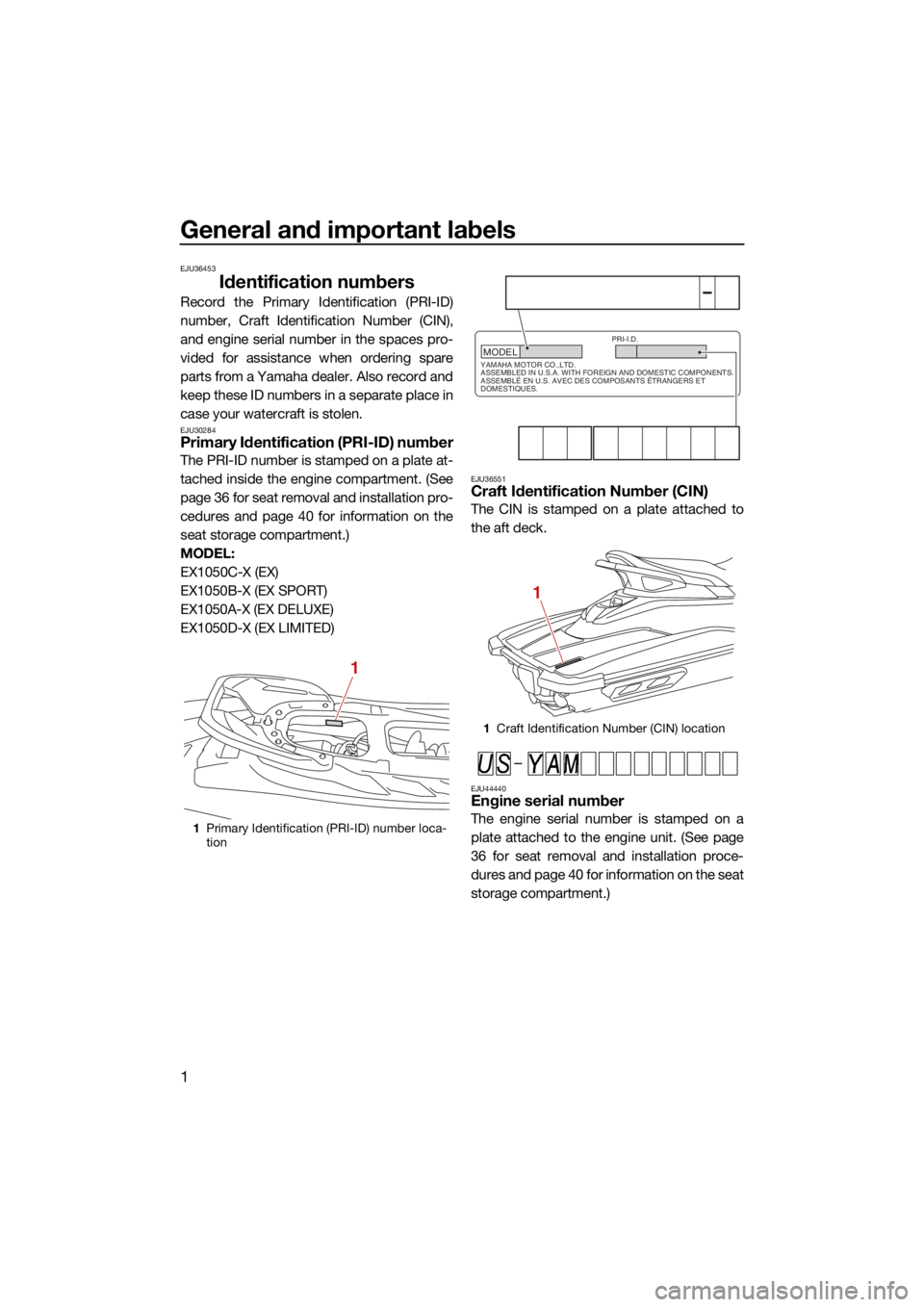
General and important labels
1
EJU36453
Identification numbers
Record the Primary Identification (PRI-ID)
number, Craft Identification Number (CIN),
and engine serial number in the spaces pro-
vided for assistance when ordering spare
parts from a Yamaha dealer. Also record and
keep these ID numbers in a separate place in
case your watercraft is stolen.
EJU30284Primary Identification (PRI-ID) number
The PRI-ID number is stamped on a plate at-
tached inside the engine compartment. (See
page 36 for seat removal and installation pro-
cedures and page 40 for information on the
seat storage compartment.)
MODEL:
EX1050C-X (EX)
EX1050B-X (EX SPORT)
EX1050A-X (EX DELUXE)
EX1050D-X (EX LIMITED)
EJU36551Craft Identification Number (CIN)
The CIN is stamped on a plate attached to
the aft deck.
EJU44440Engine serial number
The engine serial number is stamped on a
plate attached to the engine unit. (See page
36 for seat removal and installation proce-
dures and page 40 for information on the seat
storage compartment.)1Primary Identification (PRI-ID) number loca-
tion
1
1Craft Identification Number (CIN) location
MODELYAMAHA MOTOR CO.,LTD.
ASSEMBLED IN U.S.A. WITH FOREIGN AND DOMESTIC COMPONENTS.
ASSEMBLÉ EN U.S. AVEC DES COMPOSANTS ÉTRANGERS ET
DOMESTIQUES. PRI-I.D.
1
UF3Y75E0.book Page 1 Tuesday, July 27, 2021 2:27 PM
Page 9 of 100
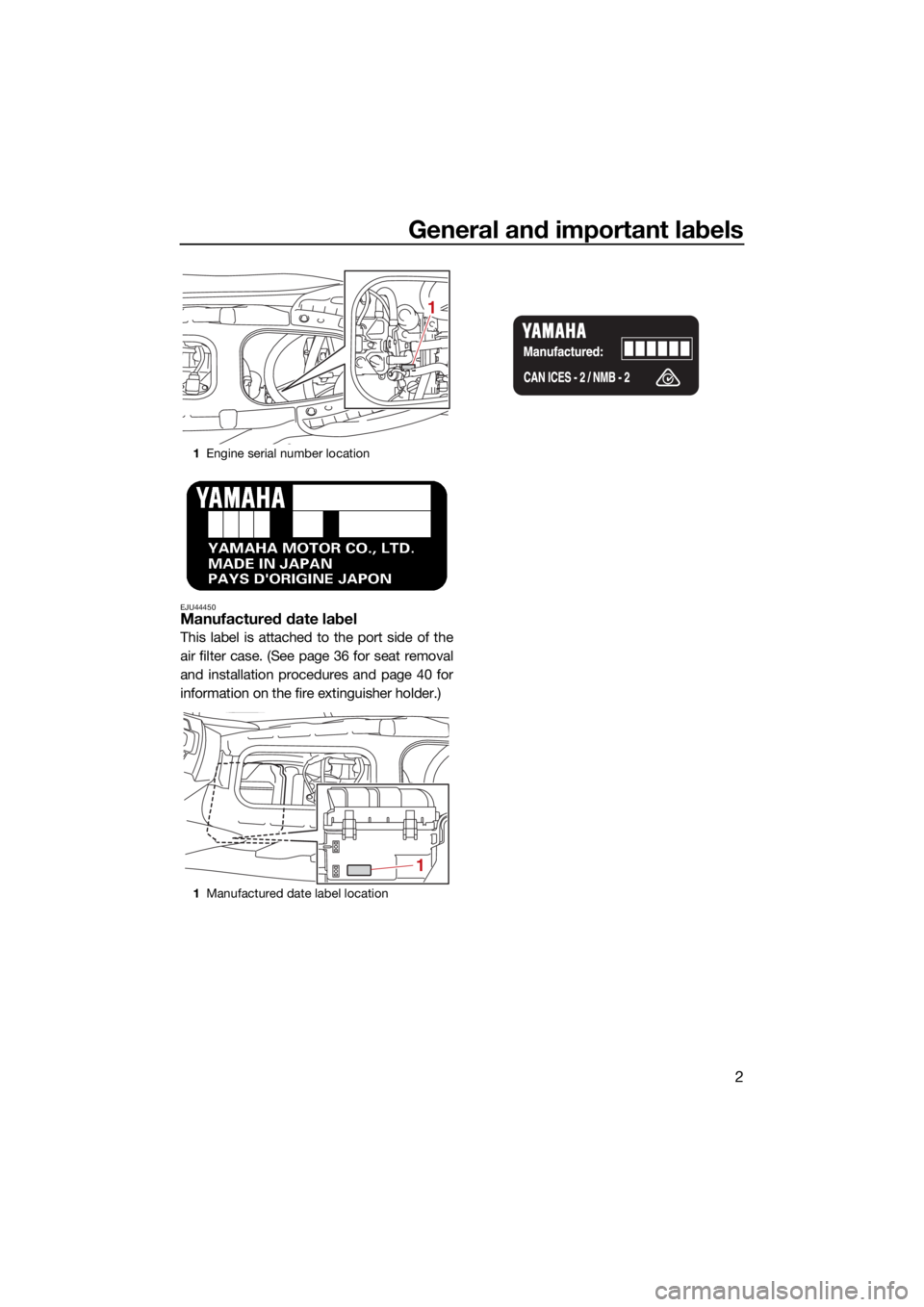
General and important labels
2
EJU44450Manufactured date label
This label is attached to the port side of the
air filter case. (See page 36 for seat removal
and installation procedures and page 40 for
information on the fire extinguisher holder.)
1Engine serial number location
1 Manufactured date label location
1
1
UF3Y75E0.book Page 2 Tuesday, July 27, 2021 2:27 PM
Page 17 of 100
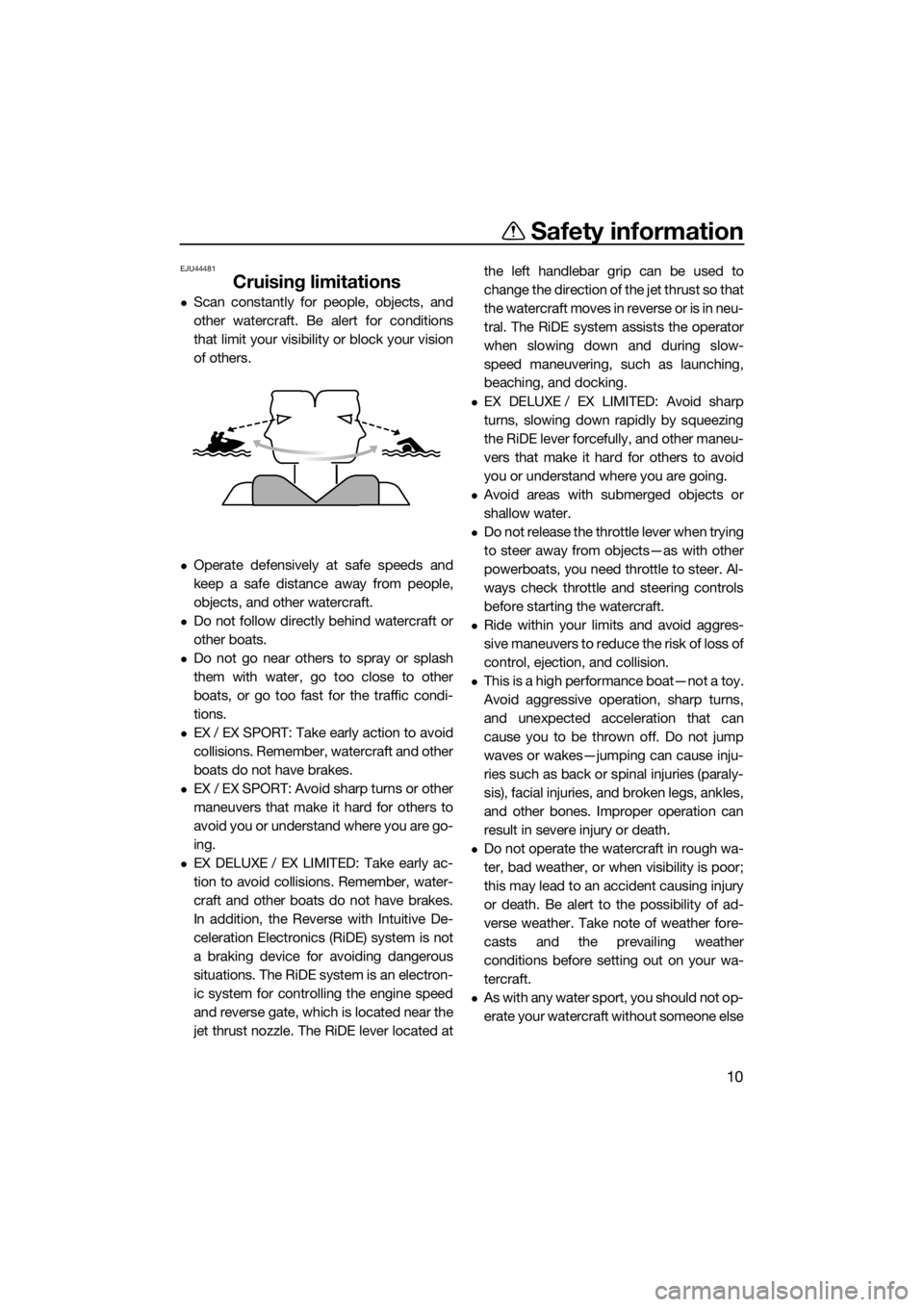
Safety information
10
EJU44481
Cruising limitations
Scan constantly for people, objects, and
other watercraft. Be alert for conditions
that limit your visibility or block your vision
of others.
Operate defensively at safe speeds and
keep a safe distance away from people,
objects, and other watercraft.
Do not follow directly behind watercraft or
other boats.
Do not go near others to spray or splash
them with water, go too close to other
boats, or go too fast for the traffic condi-
tions.
EX / EX SPORT: Take early action to avoid
collisions. Remember, watercraft and other
boats do not have brakes.
EX / EX SPORT: Avoid sharp turns or other
maneuvers that make it hard for others to
avoid you or understand where you are go-
ing.
EX DELUXE / EX LIMITED: Take early ac-
tion to avoid collisions. Remember, water-
craft and other boats do not have brakes.
In addition, the Reverse with Intuitive De-
celeration Electronics (RiDE) system is not
a braking device for avoiding dangerous
situations. The RiDE system is an electron-
ic system for controlling the engine speed
and reverse gate, which is located near the
jet thrust nozzle. The RiDE lever located atthe left handlebar grip can be used to
change the direction of the jet thrust so that
the watercraft moves in reverse or is in neu-
tral. The RiDE system assists the operator
when slowing down and during slow-
speed maneuvering, such as launching,
beaching, and docking.
EX DELUXE / EX LIMITED: Avoid sharp
turns, slowing down rapidly by squeezing
the RiDE lever forcefully, and other maneu-
vers that make it hard for others to avoid
you or understand where you are going.
Avoid areas with submerged objects or
shallow water.
Do not release the throttle lever when trying
to steer away from objects—as with other
powerboats, you need throttle to steer. Al-
ways check throttle and steering controls
before starting the watercraft.
Ride within your limits and avoid aggres-
sive maneuvers to reduce the risk of loss of
control, ejection, and collision.
This is a high performance boat—not a toy.
Avoid aggressive operation, sharp turns,
and unexpected acceleration that can
cause you to be thrown off. Do not jump
waves or wakes—jumping can cause inju-
ries such as back or spinal injuries (paraly-
sis), facial injuries, and broken legs, ankles,
and other bones. Improper operation can
result in severe injury or death.
Do not operate the watercraft in rough wa-
ter, bad weather, or when visibility is poor;
this may lead to an accident causing injury
or death. Be alert to the possibility of ad-
verse weather. Take note of weather fore-
casts and the prevailing weather
conditions before setting out on your wa-
tercraft.
As with any water sport, you should not op-
erate your watercraft without someone else
UF3Y75E0.book Page 10 Tuesday, July 27, 2021 2:27 PM
Page 19 of 100
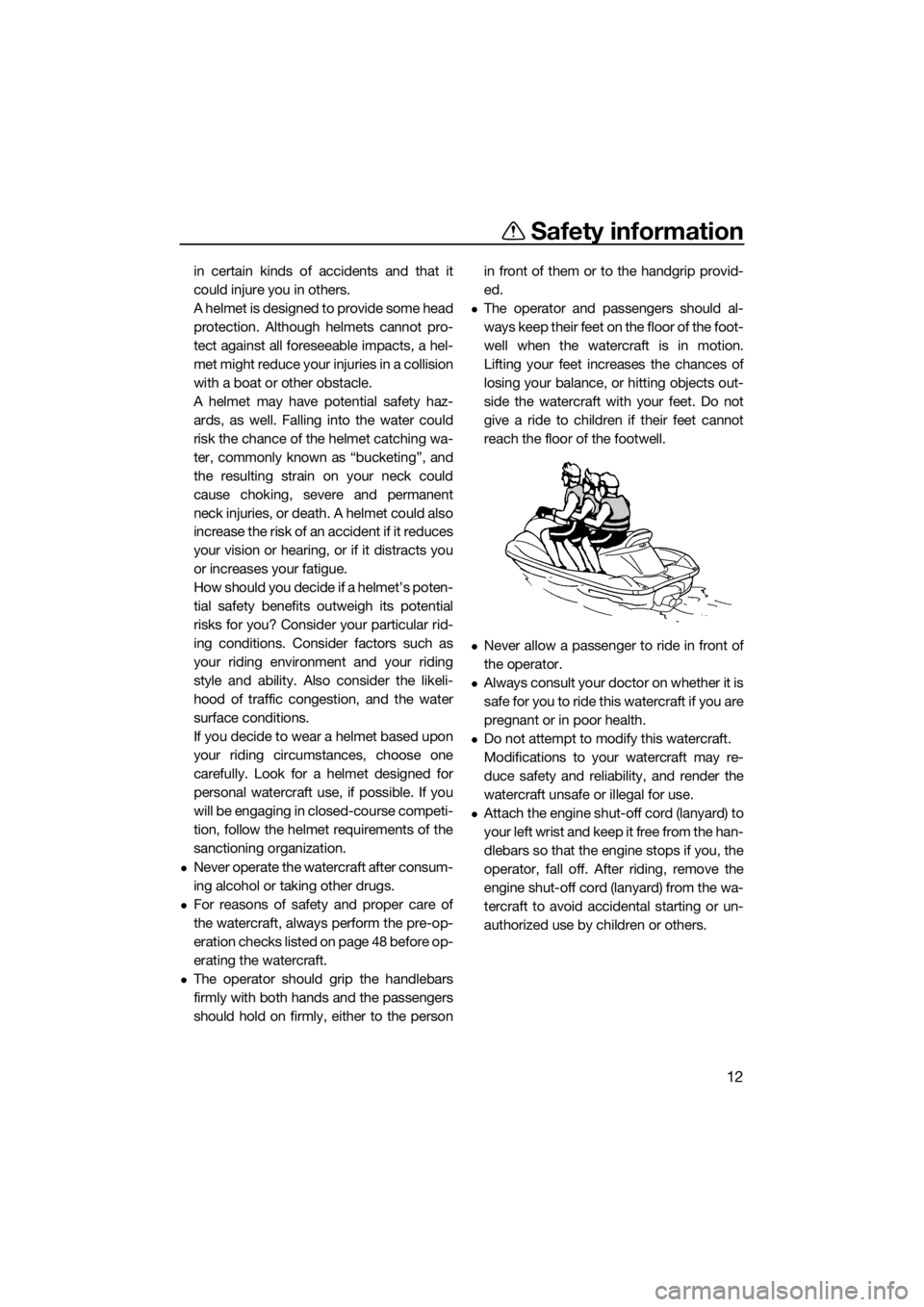
Safety information
12
in certain kinds of accidents and that it
could injure you in others.
A helmet is designed to provide some head
protection. Although helmets cannot pro-
tect against all foreseeable impacts, a hel-
met might reduce your injuries in a collision
with a boat or other obstacle.
A helmet may have potential safety haz-
ards, as well. Falling into the water could
risk the chance of the helmet catching wa-
ter, commonly known as “bucketing”, and
the resulting strain on your neck could
cause choking, severe and permanent
neck injuries, or death. A helmet could also
increase the risk of an accident if it reduces
your vision or hearing, or if it distracts you
or increases your fatigue.
How should you decide if a helmet’s poten-
tial safety benefits outweigh its potential
risks for you? Consider your particular rid-
ing conditions. Consider factors such as
your riding environment and your riding
style and ability. Also consider the likeli-
hood of traffic congestion, and the water
surface conditions.
If you decide to wear a helmet based upon
your riding circumstances, choose one
carefully. Look for a helmet designed for
personal watercraft use, if possible. If you
will be engaging in closed-course competi-
tion, follow the helmet requirements of the
sanctioning organization.
Never operate the watercraft after consum-
ing alcohol or taking other drugs.
For reasons of safety and proper care of
the watercraft, always perform the pre-op-
eration checks listed on page 48 before op-
erating the watercraft.
The operator should grip the handlebars
firmly with both hands and the passengers
should hold on firmly, either to the person in front of them or to the handgrip provid-
ed.
The operator and passengers should al-
ways keep their feet on the floor of the foot-
well when the watercraft is in motion.
Lifting your feet increases the chances of
losing your balance,
or hitting objects out-
side the watercraft with your feet. Do not
give a ride to children if their feet cannot
reach the floor of the footwell.
Never allow a passenger to ride in front of
the operator.
Always consult your doctor on whether it is
safe for you to ride this watercraft if you are
pregnant or in poor health.
Do not attempt to modify this watercraft.
Modifications to your watercraft may re-
duce safety and reliability, and render the
watercraft unsafe or illegal for use.
Attach the engine shut-off cord (lanyard) to
y o u r l ef t w r is t an d k ee p i t fr e e f r o m t h e h an -
dlebars so that the engine stops if you, the
operator, fall off. After riding, remove the
engine shut-off cord (lanyard) from the wa-
tercraft to avoid accidental starting or un-
authorized use by children or others.
UF3Y75E0.book Page 12 Tuesday, July 27, 2021 2:27 PM
Page 21 of 100

Safety information
14
EJU44610
Hazard information
Never start the engine or let it run for any
length of time in an enclosed area. Exhaust
fumes contain carbon monoxide, a color-
less, odorless gas that may cause loss of
consciousness and death within a short
time. Always operate the watercraft in an
open area.
Do not touch the hot oil tank, muffler, or en-
gine during or immediately after engine op-
eration; they can cause serious burns.
Do not place magnets or objects with a
strong magnetic force near the throttle le-
ver or RiDE lever (EX DELUXE / EX
LIMITED). The electronic throttle mecha- nism of the levers can be adversely affect-
ed, which could cause loss of control. In
addition, do not place objects susceptible
to magnetic forces (i.e., credit cards,
watches, etc.) close to the throttle lever or
RiDE lever.
EJU44341
Watercraft characteristics
Jet thrust turns the watercraft. Releasing
the throttle lever completely produces only
minimum thrust. If you are traveling at
speeds above trolling, you will have rapidly
decreasing ability to steer without throttle.
This model is equipped with the Yamaha
Engine Management System (YEMS) that
includes an off-throttle steering (OTS) sys-
tem. It will activate at planing speeds
should you attempt to steer the watercraft
after releasing the throttle lever. The OTS
system assists in turning by continuing to
supply some thrust while the watercraft is
decelerating, but you can turn more sharp-
ly if you apply throttle while turning the han-
dlebars.
The OTS system does not function below
planing speeds or when the engine is off.
Once the engine slows down, the water-
craft will no longer turn in response to han-
dlebar input until you apply throttle again or
you reach trolling speed.
Practice turning in an open area without
obstacles until you have a good feel for this
maneuver.
EX: This watercraft is water-jet propelled.
The jet pump is directly connected to the
engine. This means that jet thrust will pro-
duce some movement whenever the en-
gine is running. There is no “neutral”
position.
EX SPORT: This watercraft is water-jet pro-
pelled. The jet pump is directly connected
to the engine. This means that jet thrust will
produce some movement whenever the
engine is running. There is no “neutral” po-
sition. You are in either “forward” or “re-
verse”, depending upon the shift lever
position.
UF3Y75E0.book Page 14 Tuesday, July 27, 2021 2:27 PM
Page 22 of 100
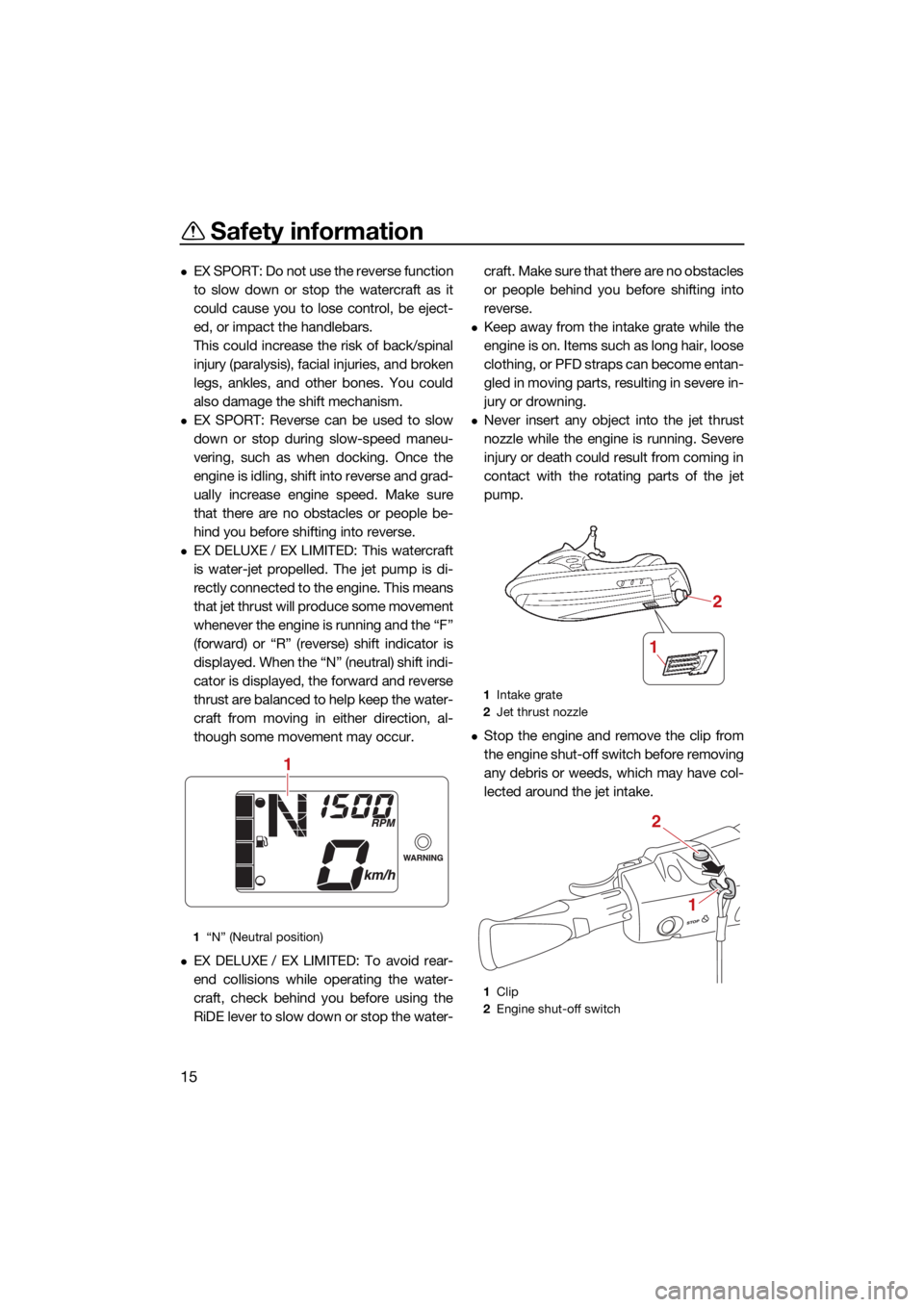
Safety information
15
EX SPORT: Do not use the reverse function
to slow down or stop the watercraft as it
could cause you to lose control, be eject-
ed, or impact the handlebars.
This could increase the risk of back/spinal
injury (paralysis), facial injuries, and broken
legs, ankles, and other bones. You could
also damage the shift mechanism.
EX SPORT: Reverse can be used to slow
down or stop during slow-speed maneu-
vering, such as when docking. Once the
engine is idling, shift into reverse and grad-
ually increase engine speed. Make sure
that there are no obstacles or people be-
hind you before shifting into reverse.
EX DELUXE / EX LIMITED: This watercraft
is water-jet propelled. The jet pump is di-
rectly connected to the engine. This means
that jet thrust will produce some movement
whenever the engine is running and the “F”
(forward) or “R” (reverse) shift indicator is
displayed. When the “N” (neutral) shift indi-
cator is displayed, the forward and reverse
thrust are balanced to help keep the water-
craft from moving in either direction, al-
though some movement may occur.
EX DELUXE / EX LIMITED: To avoid rear-
end collisions while operating the water-
craft, check behind you before using the
RiDE lever to slow down or stop the water-craft. Make sure that there are no obstacles
or people behind you before shifting into
reverse.
Keep away from the intake grate while the
engine is on. Items such as long hair, loose
clothing, or PFD straps can become entan-
gled in moving parts, resulting in severe in-
jury or drowning.
Never insert any object into the jet thrust
nozzle while the engine is running. Severe
injury or death could result from coming in
contact with the rotating parts of the jet
pump.
Stop the engine and remove the clip from
the engine shut-off switch before removing
any debris or weeds, which may have col-
lected around the jet intake.
1
“N” (Neutral position)
1
1Intake grate
2 Jet thrust nozzle
1 Clip
2 Engine shut-off switch
1
2
2
1
UF3Y75E0.book Page 15 Tuesday, July 27, 2021 2:27 PM